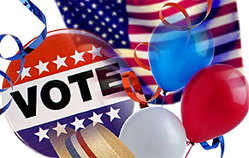I know that many conservatives have been attacking polls that show their candidate down, and I have mixed feelings on it. It’s generally not a good idea to question everything you lose. You just can’t win every state. But when people started diving deeper into the presumed turnout models for these polls, it seemed like they were taking 2008 turnout to be the assumed baseline when we know that’s not realistic.
Today, we saw that in person at our voting location. We voted at about the same time of day as we did in 2008, and the sight could not have been any different. We have two precincts that vote in different rooms at the same school, and one has a far higher percentage of Democratic voters while the other is predominantly GOP. Our neighborhood is in the mostly GOP precinct.
In 2008, the Democratic leaning precinct line was out of the room (typical), down the hall leading to the voting room (typical), and down the main hall (not atypical), and out the door (extremely out of the ordinary), and halfway down the outside of the building (unheard of), with poll workers telling people it was more than a 3 hour wait. In 2012, the line was only about an hour long and did not grow while we voted. In fact, I overheard two female voters in the line complaining that they couldn’t get their friends interested in showing up this year.
In 2008, our precinct line was short – a couple of folks in front of us and a few people behind us. IIRC, we were around 140 for the voter count for the day. Today, we were 271 & 272, and the line was longer than anything I’ve seen in 2008 or even 2010 (where it was longer than 2008’s line). Interestingly, it continued to grow while we were voting. It was still only about a 15 minute wait, but the sign in sheet was extremely heavily Republican. My name went on the sheet about 2/3 of the way down, and there were only two Democrats signed in on the page.
Enthusiasm gap much?


FWIW, at my largely Democratic polling place, about ten percent of the voters had already voted at about 9:00 AM, and — if you’re looking for an enthusiasm deficit — there did not appear to be any Republican poll workers at the door. Just two Democrats. That is unheard of, unless things had slowed down enough they had all gone for coffee. (I’ve worked those polls a lot of years in the past, and know that turnout usually falls off sharply after about 9:00 AM, before picking up again around lunchtime.)
My wife and I were asked for our ID and refused to produce it. We were told a very large number of voters already had refused, also, in addition refusing the “educational” materials they were then offered. I took the handout just for curiosity.
We weren’t asked for ID only because we both had it handy before they could ask. Poll workers manage to consistently screw up both of our names, so it’s helpful to have it out where they can see it.
Does PA have early ballot voting? I voted early in AZ and would be curious if polling locations are dead. The mail in ballot is quite popular here.
You can vote absentee, but it’s not as easy as what most states offer for “early voting.” Yes, technically it could be done, but it’s not at all common.
I voted in person, like I always do. The line for my precinct in the Suburbs of Cincinnati was at least 4 times longer than I have ever seen at 7:45.
Still only took me about 20-25 minutes to vote.
It’s funny how states treat voting differently. When I lived in the South, the whole town had to vote at the elementary school which created a long line with at least a hundred people in it. The wait was over an hour.
In California, I’ve voted all over including, one year, in someone’s garage. I’ve never had more than two people in front of me and I’ve never waited longer than five minutes to vote.
Turnout models are of course always an issue, more so in times like these, but the thing I’m wondering about even more is that the response rate is down to 9% (i.e. out of every 100 people a pollster tries to call, they only complete the process with 9). I’d need to know what numbers were like in the recent future, but I shudder to think of getting reliable results in such an “experiment” (putting on my scientist hat).